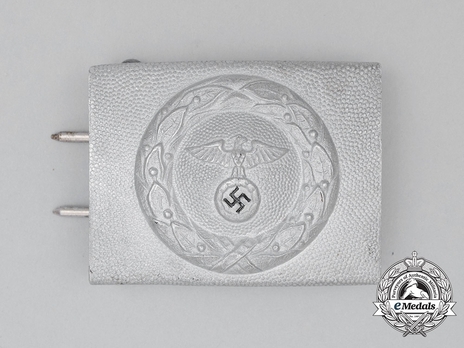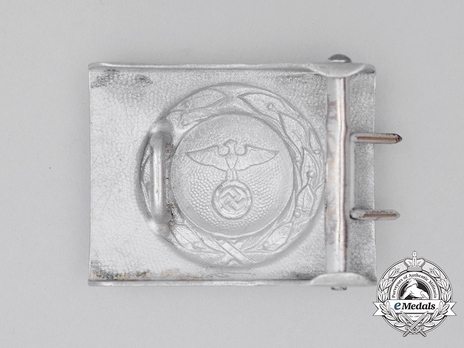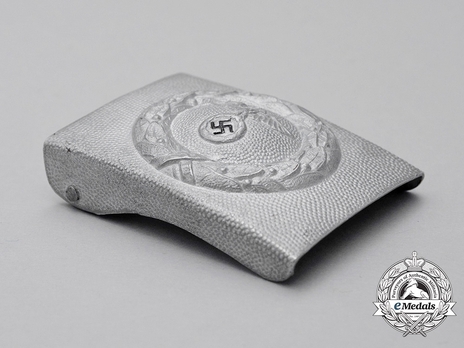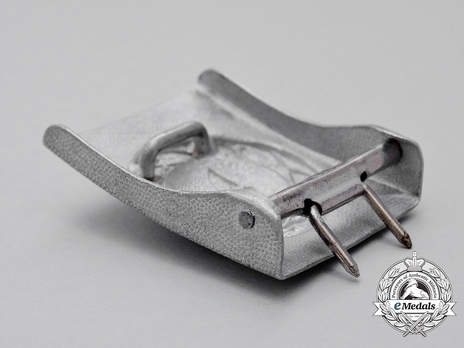RLB 1st Pattern Lower Ranks Belt Buckle (aluminum version)
CATEGORY: Version
SKU: 56.GOR.02.02.03.001.002
Estimated market value:




Estimated market value:
This is a first pattern RLB (Reichsluftschutzbund/National Air Raid Protection League) standard issue belt buckle; constructed of stamped aluminum with a silver aluminum finish; the obverse with the standard first pattern RLB motif, consisting of a small political eagle clutching a wreathed swastika on a raised pebbled field within a full laurel wreath; the reverse with a standard double-claw prongs and catch; measuring 63 mm x 48 mm; with nearly all of the original silvering intact; a seemingly unworn example; in near mint/mint condition.
Air raid protection organisations existed during the time of the Weimar Republic in the 1920s. However, in preparation for a coming war, a greater need for a centralised organisation under NSDAP control arose. It was established mere months after the NSDAP took control of Germany. The Reichsluftschutzbund (National Air Raid Protection League) or RLB was founded on April 29, 1933 under the control of Hermann Göring as Minister of Aviation. Naturally, its leader, as well as the nature of the organisation’s tasks, meant that the RLB would always have close ties to the Luftwaffe. All previously founded air raid protection organisations ceased to exist or were forcefully absorbed into the RLB.
The RLB’s function was to train the public on how to prepare for and deal with enemy air raids, and act as a supervisor of civil protection and defense, for both private homes and for places of work. Therefore, the RLB’s focus was split up into what was referred to as Selbstschutz (self-defense) for homes and Erweiterter Selbstschutz (extended self-defense) for places of work. Air raid protection of industry that was deemed essential to the war effort was referred to as Werkluftschutz (Factory Air Raid Protection) or WLS.
The core of the organisation was made up of high-ranking Luftwaffe officers (the RLB leader was always a Luftwaffe General) and a number of full-time salaried RLB members. These professional RLB members made up only a minority of the organisation, since the vast majority of members were, in fact, volunteers. Eventually, a law passed on June 26, 1935 made it a legal duty for almost everybody to receive training by the RLB.
In May of 1937, the Sicherheits- und Hilfsdienst (Security and Assistance Service) or SHD was founded. This was meant as a sister organisation of the RLB made up of professionals rather than amateurs, including firefighters, medical personnel, and specialist troops like public utilities repair service, gas decontamination service, or salvage crews.
At the same time, the Luftschutzwarndienst (Air Raid Warning Service) or LSW was founded. It was intended as an intermediary between the Flugmeldedienst (Flight Message Service) and the air raid protection organisations. The Flugmeldedienst was responsible for spotting enemy aircraft and determining their likely targets, so the population could receive a warning before an attack was carried out.
The SHD was split in the spring of 1942, with the Luftwaffe taking control of its mobile (motorised) units, and the Police taking control of its static units under the name of Luftschutzpolizei (Air Raid Defense Police).
The water-related units were formed into a new organisation, the Wasserstraßenluftschutz (Waterways Air Defense) or WSL. This organisation was entirely separate from and not affiliated with the Wasserschutzpolizei, the Water Protection Police. The WSL’s creation was officially announced on June 1, 1942.
The first uniform regulations for the RLB were published on March 7, 1934. At that point, RLB members had already been wearing belt buckles of another organisation for almost a year, the DLV (Deutscher Luftsportverband = German Air Sports Assocation).
All lower rank belt buckles were worn with a 44mm wide black leather belt.
The 1st pattern lower ranks belt buckle was introduced in March of 1933. It is rectangular and measures 63x47mm. The buckle is matte-silver and made of white metal, mostly steel or nickel-plated steel.
It features a “political” eagle emblem inside a laurel wreath on a pebbled field with a domed centre. The eagle’s head faces to the viewer’s right. The wings are slightly down-turned. In this, it differs from the very similar DLV buckle, where the eagle’s wings are straight. However, the difference is so subtle that the two models were probably worn interchangeably between the two organisations. The mobile swastika in the eagle’s talons is black.

Comments
Sign in to comment and reply.


Scroll Top